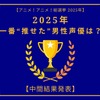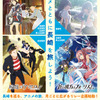At the start of many DVDs from the now-sort-of-defunct ADV Films, a promotional video would play that explained the question “What is anime?”.

2025年一番“推せた”男性声優は?【中間結果発表】内山昂輝、中村悠一、神谷浩史…今年もメインキャラを複数演じた人気キャストが上位に!

The Japanese Adventure Game That Japan Didn't Make

長崎県、人気アニメ4作品と“リレー形式”で連動 舞台地域を周遊する聖地企画 実施中!!